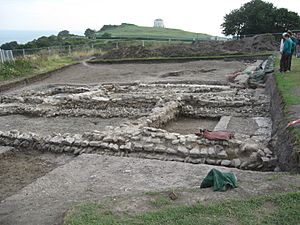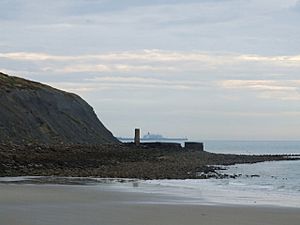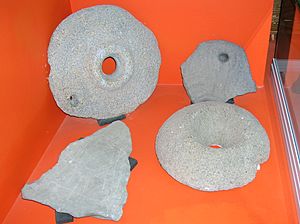Folkestone Roman Villa facts for kids
The Folkestone Roman Villa, also known as the East Bay Site, is an ancient Roman country house built when the Romans lived in Britain. It's located in East Wear Bay, near the town of Folkestone in Kent, England. The villa sits high on a cliff, looking out over the English Channel. On a clear day, you can even see the coast of France!
This area has been home to people for thousands of years. Archeologists have found tools and other items from the Stone Age (Mesolithic and Neolithic periods) both near and at the villa site. The villa itself was built around 75 AD. It was likely constructed on top of an even older settlement from the Iron Age.
The villa was rebuilt and made much bigger around the 2nd century AD. This new version was quite fancy, with beautiful mosaics, a bath-house, and possibly a second building connected by a courtyard. The villa was left empty in the 3rd century, but people briefly lived there again in the 4th century before it was finally abandoned.
Contents
Why is the Villa on a Cliff?
The Roman villa and an older Iron Age workshop are built on a low, crumbling cliff. This cliff is made of a thick layer of soft clay that sits on top of a type of sandstone. The sandstone here is special to Folkestone and is full of fossils.
The soft clay layer often gets very wet and slippery. This causes parts of the cliff to slide into the sea. In Roman times, the villa was much further from the sea (about 400-500 meters). Today, it's right on the edge! The site is slowly falling into the sea, losing about 15 centimeters (6 inches) each year. Because of this, archeologists have done many "rescue excavations" to save as much as they can before it's lost forever.
A Look Back in Time
Early Humans: From Stone Age to Bronze Age
Archeologists have found signs that people lived or traveled near the villa site since the Mesolithic period (Middle Stone Age). In 2010, they found ancient flint tools buried beneath the Roman villa. These tools show that humans were definitely in the area a very long time ago.
Tools from the Neolithic period (New Stone Age) have also been found in Folkestone. There's even some evidence of a Neolithic settlement at a nearby place called Castle Hill.
Later, during the Bronze Age, an important settlement was discovered near Folkestone in 1987-1988. This was found when people were digging to build the Channel Tunnel. They found round houses, fields, pathways, and pieces of pottery from that time.
The Iron Age: A Quern-Making Factory
Before the Romans arrived, a large native settlement from the Iron Age stood on the eastern headland of the bay. This is the same spot where the Roman villa was later built. It was probably an ancient fort or town, called an oppidum.
Underneath the Roman villa, archeologists found evidence of a huge workshop. Here, people made querns, which are special stones used to grind grains into flour. They made so many that it was almost like an ancient factory! Over 60 quern-stones have been found at the site.
These querns were made from local sandstone, likely collected from a nearby place called Copt Point. Many of the querns found are unfinished or broken, suggesting they were made right there. There's even a layer of sandstone dust at the site, which is probably leftover from all the stone-working.
Querns made from Folkestone sandstone have been found in many other ancient sites. This includes places in Kent, London, and even possibly France. This suggests that the people of Folkestone traded their querns far and wide. In return, they received fine pottery from Gaul (modern-day France) and wine from Italy.
The Roman Era: A Grand Villa
The people living in Folkestone during the Iron Age seemed to have a good relationship with the Romans. When the Roman Emperor Claudius invaded Britain in 43 AD, his troops did not land at Folkestone.
Around 75 AD, the Iron Age settlement was replaced by a Roman villa. The first version of the villa was smaller, made of a light stone called tufa. The main rooms had strong, decorative floors and possibly painted walls.
The villa was rebuilt and made much grander in the 2nd century. When archeologists dug up one room in 1924, they found a thick layer of burnt material. This suggests the first villa might have been damaged by fire.
The second villa was more luxurious, with beautiful mosaic floors, painted walls, a bath-house, and even underfloor heating (called a hypocaust). It was built with local sandstone and sea-stones. Over 60 rooms have been found in three separate parts of the villa.
Tiles found at the site belong to the Classis Britannica, which was the Roman navy in Britain. This suggests the villa might have had a connection to the navy, or perhaps it was a signaling station. We don't know exactly who lived in the villa, but such large homes were usually owned by important or wealthy Romans or powerful Romano-British families.
For unknown reasons, the villa seems to have been left empty in the late 3rd century. It was briefly used again in the 4th century, then abandoned and eventually covered by soil.
Exploring the Roman Villa
Block A: The Main House
Block A is thought to be the oldest part of the villa. It was later updated when Block B was built. This building is about 65 meters (212 feet) long. It has two long hallways, or verandas, with rooms at each end.
The main entrance faced the sea. From there, you would walk through a hallway into the best room in the villa, room number 40. The rooms to the north and west of this main room had fireplaces and nice floors. These were probably the bedrooms.
The west end of the villa was likely the working area. It had the furnace, bathing rooms, kitchen, and a washing room. Room number 28 was probably the kitchen. A short passage led to a lavatorium, or washing room, with a large basin. Used water would drain out from here.
Next to the kitchen was the bathing area. Room number 29 had a hypocaust heating system, which warmed a hot plunge bath (a caldarium). The room next to it, number 30, would have been warm but not as hot (a tepidarium). Room number 36 was a cold plunge bath, about 1 meter (3 feet) deep. Three smaller rooms nearby were probably changing rooms or warming rooms.
In the center of the villa were three large rooms (numbers 40-42). These were likely the main living and entertaining spaces. The central room, number 40, had a beautiful tiled mosaic floor. It offered a magnificent view of the courtyard and the sea. This is where the villa owner would have entertained guests. An older floor was found beneath the mosaic, showing the villa had been rebuilt. Room number 41 shows clear signs of being burnt, which might explain why the villa was renovated.
Block B: Another Important Building
Block B was built at the same time Block A was renovated. It also had many similar features, including a hypocaust (underfloor heating), Roman baths, a kitchen, and a very large heated room. Sadly, part of Block B had already fallen over the cliff when archeologists first dug there in 1924.
Digging Up the Past
People knew about the Roman Villa site for many years before it was officially excavated. In the 1700s, farmers found it hard to plow the land because of "old stones" that damaged their equipment.
In 1919, a museum curator named Mr. Browne Anderson dug a small trench. But it wasn't until 1924 that the site was fully excavated by S. E. Winbolt. The site became a popular place for tourists to visit until World War II began. During the war, the area was used for gun positions, and the site was closed. (When archeologists dug again in 2010, they even saw tank tracks across the Roman walls!)
The site reopened in 1945 but continued to crumble. Because there wasn't enough money to protect it after the war, the decision was made to cover the site with waste material from a nearby incinerator.
The site was re-excavated in 1989. This was a joint effort to find the villa remains, check how much of the Roman walls were left, and see how much had fallen over the cliff since 1924. Some repairs were made before the villa was covered again for the winter.
The most recent excavation happened from 2010 to 2011. This was part of a big project called "A Town Unearthed: Folkestone Before 1500." It was a huge success and even won the "Rescue Dig of the Year" award from Current Archaeology magazine!






